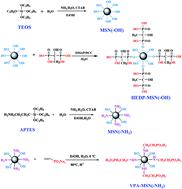当前位置:
X-MOL 学术
›
Sustain. Energy Fuels
›
论文详情
Our official English website, www.x-mol.net, welcomes your
feedback! (Note: you will need to create a separate account there.)
A self-humidifying proton exchange membrane embedded with phosphonic acid-functionalized mesoporous silica nanoparticles that has excellent dispersion and water retention
Sustainable Energy & Fuels ( IF 5.0 ) Pub Date : 2020-11-11 , DOI: 10.1039/d0se01339k Henghui Huang 1, 2, 3, 4 , Shaoyi Xu 1, 2, 3, 4, 5 , Li Zhang 2, 4, 6, 7 , Jiantao Fan 1, 2, 3, 4, 5 , Hui Li 1, 2, 3, 4 , Haijiang Wang 2, 4, 6, 7
Sustainable Energy & Fuels ( IF 5.0 ) Pub Date : 2020-11-11 , DOI: 10.1039/d0se01339k Henghui Huang 1, 2, 3, 4 , Shaoyi Xu 1, 2, 3, 4, 5 , Li Zhang 2, 4, 6, 7 , Jiantao Fan 1, 2, 3, 4, 5 , Hui Li 1, 2, 3, 4 , Haijiang Wang 2, 4, 6, 7
Affiliation

|
Nanomaterials with a uniform size, large surface area, high adsorption capacity, and excellent dispersion are critical to proton conduction and cell performance when functionalized and incorporated into a proton exchange membrane. We designed and fabricated a novel composite PEM based on vinylphosphonic acid-functionalized mesoporous silica nanoparticles (VPA-MSNs), with the aim of improving the cell performance and proton conductivity of a perfluorosulfonic acid (PFSA) membrane under low relative humidity (RH) conditions. The experimental results show that the VPA-MSN(–NH2)/PFSA composite membrane provides a proton conductivity of up to 23.2 mS cm−1 at 30% RH and up to 9.6 mS cm−1 at 10% RH, which are respectively 3.2 and 8.6 times higher than those of a pristine PFSA membrane, and 5.6 and 10.4 times higher than those of a commercial Nafion membrane. In addition, the VPA-MSN(–NH2)/PFSA composite membrane exhibits superior fuel cell performance and low ohmic resistance at low relative humidity. Improvements in water absorption/retention, proton conductivity, and single-cell performance resulted from these effectively hydrophilic surfaces and mass transfer pathways, as the mesoporous structure and abundant functional groups in the membrane enhanced the connectivity of the hydrophilic zone, forming new proton transport channels. The incorporation of VPA-MSNs into the PFSA matrix also enhanced the water retention properties and mechanical strength, and adjusted the organic–inorganic interface and hydrophilic ionic domains inside the membranes simultaneously. The results indicate that this new type of VPA-MSN(–NH2)/PFSA composite membrane is promising for developing PEMs that tolerate variations in humidity.
中文翻译:

嵌入膦酸官能化介孔二氧化硅纳米粒子的自增湿质子交换膜,具有出色的分散性和保水性
纳米材料具有均匀的尺寸,大的表面积,高的吸附能力和出色的分散性,当功能化并结合到质子交换膜中时,对于质子传导和电池性能至关重要。我们设计和制造了一种基于乙烯基膦酸官能化的介孔二氧化硅纳米粒子(VPA-MSNs)的新型复合PEM,目的是在低相对湿度(RH)条件下改善全氟磺酸(PFSA)膜的电池性能和质子传导性。实验结果表明,该VPA-MSN(-NH 2)/ PFSA复合膜提供了一个质子传导性,以23.2毫秒厘米-1,在30%RH和至多9.6毫秒厘米-1相对湿度为10%时,分别比原始PFSA膜高3.2倍和8.6倍,比市售Nafion膜高5.6和10.4倍。此外,VPA-MSN(–NH 2)/ PFSA复合膜在低相对湿度下表现出优异的燃料电池性能和低欧姆电阻。这些有效的亲水表面和传质途径改善了水的吸收/保留,质子传导性和单电池性能,因为膜中的中孔结构和丰富的官能团增强了亲水区的连通性,形成了新的质子传输通道。将VPA-MSN掺入PFSA基质还增强了保水性能和机械强度,并同时调节了膜内的有机-无机界面和亲水性离子域。结果表明,这种新型的VPA-MSN(–NH 2/ PFSA复合膜有望用于开发可耐受湿度变化的PEM。
更新日期:2020-11-21
中文翻译:

嵌入膦酸官能化介孔二氧化硅纳米粒子的自增湿质子交换膜,具有出色的分散性和保水性
纳米材料具有均匀的尺寸,大的表面积,高的吸附能力和出色的分散性,当功能化并结合到质子交换膜中时,对于质子传导和电池性能至关重要。我们设计和制造了一种基于乙烯基膦酸官能化的介孔二氧化硅纳米粒子(VPA-MSNs)的新型复合PEM,目的是在低相对湿度(RH)条件下改善全氟磺酸(PFSA)膜的电池性能和质子传导性。实验结果表明,该VPA-MSN(-NH 2)/ PFSA复合膜提供了一个质子传导性,以23.2毫秒厘米-1,在30%RH和至多9.6毫秒厘米-1相对湿度为10%时,分别比原始PFSA膜高3.2倍和8.6倍,比市售Nafion膜高5.6和10.4倍。此外,VPA-MSN(–NH 2)/ PFSA复合膜在低相对湿度下表现出优异的燃料电池性能和低欧姆电阻。这些有效的亲水表面和传质途径改善了水的吸收/保留,质子传导性和单电池性能,因为膜中的中孔结构和丰富的官能团增强了亲水区的连通性,形成了新的质子传输通道。将VPA-MSN掺入PFSA基质还增强了保水性能和机械强度,并同时调节了膜内的有机-无机界面和亲水性离子域。结果表明,这种新型的VPA-MSN(–NH 2/ PFSA复合膜有望用于开发可耐受湿度变化的PEM。











































 京公网安备 11010802027423号
京公网安备 11010802027423号